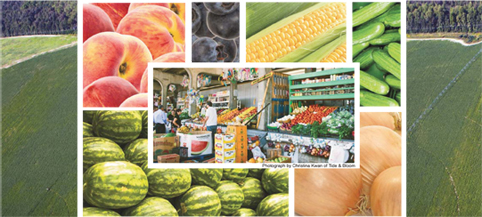Imports can also be a blessing if Mother Nature lobs a few curve balls at sweet onion growers. “Weather had an effect on the Vidalia industry this year,” Shuman admits. “Rain caused some quality issues early in the season in April, and contributed to additional concerns with the storage crop in June and July.”
All in all, though, this year’s sweet onion crop has been a good one. “When you consider that a region so small produces a sweet onion so famous and available throughout the country,” Shuman enthuses, “that makes the Vidalia onion a pretty special product.” Basically, what it comes down to is simple: taste—and this is confirmed year after year by the sweet onion’s devoted fans.
Fabulous Fruit
Fruits and nuts are also significant contributors to the Georgia economy, bringing in over $2 billion and supporting over 18,900 jobs. Though the item array is less diverse than vegetables, it is no less impressive. Top fruits include blueberries, peaches, apples, strawberries, grapes, and blackberries, with pecans and peanuts representing nuts.
Blueberry and pecan production far outpace Georgia’s namesake peaches, with 42 and 43 percent of the state’s fruit and tree nut production respectively. Despite their modest share of the state’s fruit production, fresh Georgia peaches are still a favorite with more than 40 different commercial varieties, grown mostly in the middle of the state.
Georgia peaches are only available for 16 weeks a year and over 2.6 million cartons are produced annually. The fruit benefits from tailor-made marketing campaigns such as the “Georgia in July” retail program, which plays on the peaches’ taste and reliability to boost produce sales.
Turning to another mainstay, the state’s second most important fruit by is the blueberry.
Over the past five years, blueberry production has soared in Georgia with state agriculture analysts predicting it won’t be long before blueberries outpace pecans in the fruit and nut category. Georgia now earns more than $300 million annually from blueberry production, with increases expected to continue for the next several years.
Lastly, although Georgia isn’t well known for its wine, the state does lead the nation in the production of muscadine grapes. Muscadines were originally a wild variety found by Sir Walter Raleigh in 1584, but today there are a number of cultivars used for juices, jams, jellies, syrups, and wine.
KEEPING IT CLOSE TO HOME
As in many other states, the locally grown movement is going strong—and why wouldn’t it with homegrown darlings like peaches, blueberries, and Vidalia onions? Georgia Grown, the state’s marketing and economic development program, continues to gain momentum with many events and activities to connect the state’s produce industry to residents. Events include everything from book launches to cooking demonstrations with seasonal recipes.



